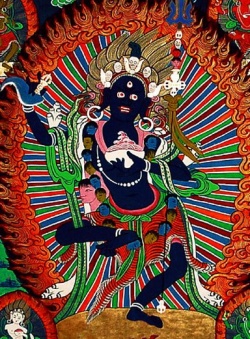Difference between revisions of "MAHAVISNU"
| (5 intermediate revisions by the same user not shown) | |||
| Line 1: | Line 1: | ||
| − | <nomobile>{{DisplayImages|798 | + | <nomobile>{{DisplayImages|798}}</nomobile> |
| − | [[Mahavishnu]] ([[Devanāgarī]] : [[महाविष्णु]]) is an aspect of [[Vishnu]], the [[Absolute]] which is beyond [[human]] [[comprehension]] and is beyond all [[attributes]]. In [[Gauḍīya | + | [[Mahavishnu]] ([[Devanāgarī]] : [[महाविष्णु]]) is an aspect of [[Vishnu]], the [[Absolute]] which is beyond [[human]] [[comprehension]] and is beyond all [[attributes]]. In [[Wikipedia:|Gauḍīya Vaishnavism]] , a school of {{Wiki|Vaiṣṇavism}}, the [[Sātvata-tantra]] describes three different [[forms]], or aspects, of [[Vishnu]] as [[Mahavishnu]], {{Wiki|Garbhodakśayī-Viṣṇu}} and [[Wikipedia:|Kṣīrodakaśāyī Vishnu]] . |
The term [[Mahavishnu]] is similar to [[Brahman]] and [[Almighty Absolute Supreme Personality of Godhead]]. This means that the [[Absolute truth]] is [[realized]] first as [[Brahman]] ({{Wiki|impersonal}} aspect) then as [[Paramatma]] (personal aspect) and finally as [[Bhagavan]] ([[incarnate]] [[perfection]]). | The term [[Mahavishnu]] is similar to [[Brahman]] and [[Almighty Absolute Supreme Personality of Godhead]]. This means that the [[Absolute truth]] is [[realized]] first as [[Brahman]] ({{Wiki|impersonal}} aspect) then as [[Paramatma]] (personal aspect) and finally as [[Bhagavan]] ([[incarnate]] [[perfection]]). | ||
| Line 8: | Line 8: | ||
[[Mahavishnu]] is said to lie in the [[causal ocean]] or the [[Karanodak]]. He puts the seed of this [[material universe]] in [[Mahāmāyā]] by glancing at her. [[Mahāmāyā]] remains the ever obedient material [[energy]] of the Supreme Lord. All the natural [[elements]] including sky, [[fire]], [[water]], [[air]] and land are created along with [[mind]], [[intelligence]] and false [[ego]]. | [[Mahavishnu]] is said to lie in the [[causal ocean]] or the [[Karanodak]]. He puts the seed of this [[material universe]] in [[Mahāmāyā]] by glancing at her. [[Mahāmāyā]] remains the ever obedient material [[energy]] of the Supreme Lord. All the natural [[elements]] including sky, [[fire]], [[water]], [[air]] and land are created along with [[mind]], [[intelligence]] and false [[ego]]. | ||
| − | After this, [[Mahavishnu]] enters each of the many [[universes]] so created ([[seeds]] [[emerging]] from the pores of His {{Wiki|skin}}) as [[Garbhodaksayi Vishnu]], who lays down in each and every of these {{Wiki|individual}} material [[universes]] ([[Brahmandas]]). It can be interpreted that [[Garbodakshayi Vishnu]] is the collective [[soul]] of all [[souls]] in a particular [[material universe]] and that [[Mahavishnu]] is the collective [[soul]] of all [[souls]] in all of the material [[universes]]. | + | After this, [[Mahavishnu]] enters each of the many [[universes]] so created ([[seeds]] [[emerging]] from the pores of His {{Wiki|skin}}) as [[Wikipedia:|Garbhodaksayi Vishnu]], who lays down in each and every of these {{Wiki|individual}} material [[universes]] ([[Brahmandas]]). It can be interpreted that [[Wikipedia:|Garbodakshayi Vishnu]] is the collective [[soul]] of all [[souls]] in a particular [[material universe]] and that [[Mahavishnu]] is the collective [[soul]] of all [[souls]] in all of the material [[universes]]. |
| − | From [[Garbodakshayi Vishnu]] then emerges [[Brahmā]] who is the secondary creator (due to his need to [[meditate]] to create {{Wiki|planets}} in the [[material universe]]) of the {{Wiki|planetary}} systems within particularly this [[material universe]] ([[Brahmanda]]). | + | From [[Wikipedia:|Garbodakshayi Vishnu]] then emerges [[Brahmā]] who is the secondary creator (due to his need to [[meditate]] to create {{Wiki|planets}} in the [[material universe]]) of the {{Wiki|planetary}} systems within particularly this [[material universe]] ([[Brahmanda]]). |
| − | {{ | + | {{W}} |
[[Category:Buddhist Cosmology]] | [[Category:Buddhist Cosmology]] | ||
Latest revision as of 06:54, 19 September 2015
Mahavishnu (Devanāgarī : महाविष्णु) is an aspect of Vishnu, the Absolute which is beyond human comprehension and is beyond all attributes. In Gauḍīya Vaishnavism , a school of Vaiṣṇavism, the Sātvata-tantra describes three different forms, or aspects, of Vishnu as Mahavishnu, Garbhodakśayī-Viṣṇu and Kṣīrodakaśāyī Vishnu .
The term Mahavishnu is similar to Brahman and Almighty Absolute Supreme Personality of Godhead. This means that the Absolute truth is realized first as Brahman (impersonal aspect) then as Paramatma (personal aspect) and finally as Bhagavan (incarnate perfection).
So bhakti (loving devotion) goes to Bhagavan, Krishna (the Avatar of Vishnu, Narayana). In this way, bhakti surpasses even yoga, which is aimed at the Supersoul, Paramatma. Mahavishnu is the Supersoul of all living beings (jivaatmas) in all material universes. It is also often used interchangeably with Vishnu to indicate reverence, as the prefix "Mahā" exalts the noun to which it is attached. It is believed that Adi Parashakti has been created by Maha Vishnu to maintain the Material Universe. So Parashakti is working under the direction of Maha vishnu. So all the Gods including Shiva, Parashakti, Brahma are considered as the Part of Maha Vishnu Expansion.
Mahavishnu is said to lie in the causal ocean or the Karanodak. He puts the seed of this material universe in Mahāmāyā by glancing at her. Mahāmāyā remains the ever obedient material energy of the Supreme Lord. All the natural elements including sky, fire, water, air and land are created along with mind, intelligence and false ego.
After this, Mahavishnu enters each of the many universes so created (seeds emerging from the pores of His skin) as Garbhodaksayi Vishnu, who lays down in each and every of these individual material universes (Brahmandas). It can be interpreted that Garbodakshayi Vishnu is the collective soul of all souls in a particular material universe and that Mahavishnu is the collective soul of all souls in all of the material universes.
From Garbodakshayi Vishnu then emerges Brahmā who is the secondary creator (due to his need to meditate to create planets in the material universe) of the planetary systems within particularly this material universe (Brahmanda).
